Water control structures for inland-valley lowlands
Installation of water control structures in inland-valley lowlands should allow better water management; depending on the region and the inland valley this means:
-
Storing more water on the inland-valley lowland fields (for relatively dry areas)
-
Distributing the water over a larger surface
-
Evacuating/draining excess water (in very wet areas)
-
Being able to drain excess water, but also preserve water to extend the growing season (a very frequent requirement).
Five water control systems will be presented here: contour bunds, water-retention dikes, diversion barriers, interception canal systems, and small dams. Contour bunds and water-retention dikes store water on the fields upstream of the bunds or dikes. Diversion barriers divert water from the lower parts in the center of the valley towards the borders, in order to allow irrigation of fields downstream of the barrier. Building a dam is an expensive solution (several million FCFA/ha or about 3,000 to 5,000 euros/ha), and is, therefore, only an option for relatively large inland valleys, but it is the only system that allows full water control.
Contour bunds
Contour bunds are the simplest and cheapest form of water control. These bunds are small dikes made of soil material, built in the valley bottom and following its contour lines. As valley bottoms are often slightly concave, the bunds will have a parabolic shape. Such a shape allows redistribution from the central part of the valley bottom to the sides. The objective of this water control system is to store water on the rice fields and allow excess water to pass over the bunds. The contour-bund water control system can be divided into two sub-systems: simple contour bunds and contour bunds with a spillway.
The simple contour bund system is shown in Figure 5.1. The 30-cm high earthen bunds store and divide the water over the fields. The slope of the valley bottom defines the distance between bunds. If the slope of the valley bottom is relatively steep, the bunds have to be rather close to each other. Earthen bunds are sensitive to erosion. This means that the amount of water that is allowed to flow through the system, i.e. over the bunds, is limited. This system retains rainfall that falls on the field or comes in from upstream fields, and can store water up to the height of the bund. This very simple system can extend the growing season in some situations by up to 20 or even 50 days. However, it will only perform well if lowland soils have relatively high clay content, i.e. percolation losses are negligible, if the valley bottom has a relatively gentle slope and if water flow is not too strong (otherwise bunds will not resist it).
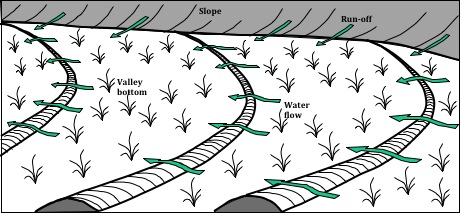
Figure 5.1 Simple contour bunds.
The contour bund system with spillways is shown in Figure 5.2. The concept of this water control system is the same as the simple contour-bund system, but it is adapted to situations with high water flow through the inland valley. To enable the flow of a greater volume of water through the system, while avoiding erosion of the bunds, the bunds are 50 cm high. Moreover, spillways are installed in the bunds to evacuate excess water. These spillways have to be relatively wide to reduce the risk of erosion. They can be made of soil material, but have to be protected from erosion by (e.g.) plastic sheets. Spillways may also be constructed using sand bags or concrete.
As for the simple contour bunds, slope and soil permeability should not be too high, but the peak flow may be higher. A central drainage canal may be added to the system to facilitate evacuation of water flow.
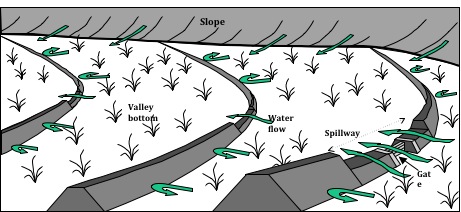
Figure 5.2. Contour bund system with spillway
Water-retention dikes
The principle of water-retention dikes is shown in Figure 5.3. These dikes are bigger and more robust than bunds, because they should be able to resist higher water pressures. The dikes are constructed perpendicularly to the valley bottom. In the dike, a gate is installed to regulate the water level and drain excess water. The water-retention dike dams up the water, and the flooded zone upstream of the dike is used for rice cultivation. Two different water-retention dikes are distinguished: the dikes with and without a seepage barrier.
Water-retention dikes can be introduced in inland-valley lowlands with decennial peak flow of less than 130 L/s per meter of valley-bottom width, with low longitudinal slopes, a shallow stream channel (to avoid too much pressure on the dike) and a soil permeability that is not too high (otherwise there would be too much leakage).
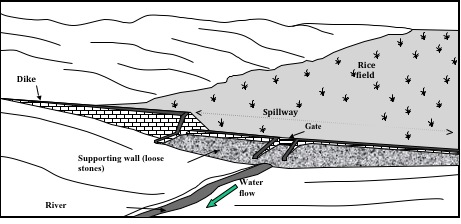
Figure 5.3 Water-retention dike
If the permeability of the valley-bottom soils is very high, water losses through seepage underneath the retention dike become important and should be avoided. This can be done by constructing an underground seepage barrier by digging a trench and filling this with fine-textured material (Figure 5.4). To avoid seepage losses, the seepage barrier should be constructed on a subsoil layer with low permeability. The costs of seepage-barrier construction will depend on the depth of this impermeable layer. When the permeability of the lowland soils is high, the maximum depth of the impermeable layer should be less than 2 m, to make the construction of the retention dike with a seepage barrier economically profitable. When the impermeable layer is deeper than 2 m, another water management system can be applied (see below).
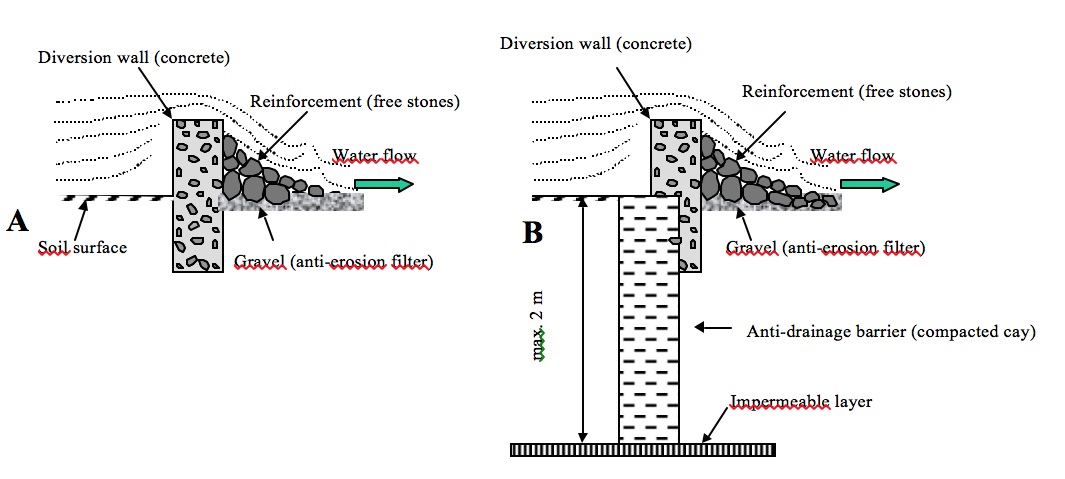
Figure 5.4. Schematic cross-section of water-retention dikes without (A) and with (B) a seepage barrier
Diversion barriers
This type of water control system can be used in valley bottoms were a well-developed stream channel is present. In this stream channel, a concrete construction is made to dam up the water. After being dammed up, the water can be directed into peripheral canals to divert it to the sides of the valley bottom. Because the sides of the valley bottom are often slightly higher than the central part, the water in the canals can be used for surface irrigation of the bunded rice fields by gravity. The original stream canal can then be used for drainage of the rice fields and to drain the excess of water that is not diverted into the irrigation canals by the diversion structure (Figure 5.5).

Figure 5.5 Diversion barrier to diffuse flow
This kind of system may be used in valley bottoms that have a longitudinal slope of less than 1% and a decennial peak flow of up to 200 L/s per meter of valley bottom width, in which the soils have a low permeability. Moreover, this system will only be profitable when the base flow covers the irrigation requirement of the crop for at least one month a year.
The diversion-barrier system is commonly used in Côte d’Ivoire (prise au fil de l’eau) and in Guinea. In Benin and Nigeria, the system of irrigation water through diverting water to peripheral canals is also used. In these last two countries, however, the water is not diverted from the stream canal into the peripheral canals by constructing a diversion barrier in the stream canal. Rather, water-retention dikes are constructed across the valley bottom in which two outlets are constructed through which the water flows directly into the peripheral (irrigation) canals. The main bunds between the rice fields can be constructed along the contour lines or the rice plots may have a rectangular field layout.
When the permeability of the valley bottom soils is rather high, surface irrigation will be difficult because large amounts of water will be lost through seepage. However, a diversion barrier may still be used (Figure 5.6), but the main objective changes from surface irrigation to recharging the groundwater table. Under such an approach, the groundwater level can be kept at (or near) the surface. The diversion barrier is the same, but will divert the water into canals across the valley bottom. From these canals, the water will seep into the soil and the groundwater will rise. Due to the constant flow of water, the groundwater level will remain high and crops will use this groundwater as a supplementary source of water.
For this management system, one additional physical criterion has been formulated. Recharging the groundwater table will be possible if the depth of the natural groundwater table is not too deep. In Mali-Sud this system worked when the groundwater was within 2 m of the surface at the beginning of January.
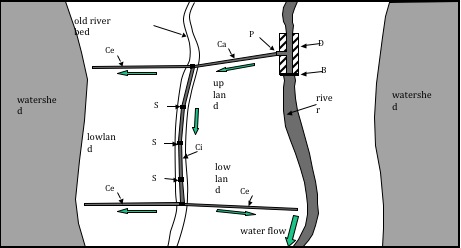
Figure 5.6 Diversion barrier for infiltration
Interception canal system
In very humid areas, it is necessary to increase the drainage of excess water during the main rainy season to avoid damage to the rice crop. This is done by widening and deepening the central drain and by constructing peripheral canals along the sides of the valley bottom. The main function of these peripheral canals is to intercept surface run-off and sub-surface groundwater flow from the uplands to the lowlands, decreasing water inflow and thus water excess in the lowland.
Small dam system
One of the most common water management systems not described above is the small dam that creates an artificial lake. The water from the lake will be used to irrigate the downstream parts of the valley. It is possible to cultivate rice (Côte d’Ivoire forest and savanna zones, and Guinea) or other crops during the rainy season (Burkina Faso), or dry-season crops (in several countries). An artificial lake allows the full control of irrigation water. However, this system is not considered to be an option for small inland valleys, because of the high construction costs of the dam and canals.
Maintenance of the development structures
The maintenance of irrigation and drainage structures is very important: water has to circulate easily and regularly, as any narrowing will increase the power of water or block it completely. Blocked irrigation canals obviously may cause flooding upstream and drought problems down stream. In case of floods, blocked drainage canals may not be able to evacuate water following the most direct route, which may lead to severe erosion damage.
Bunds
The main role of bunds is to keep the water in the plots. They also serve as walking paths between the plots. They degrade relatively rapidly because of water force, walking and rat damage. It is important to repair bunds before the start of the growing season.
Canals
Blocked canals full of weeds hinder the circulation of irrigation water. They also are pathways for weed seeds to enter the rice fields. Cleaning the canals before the beginning of the campaign is, therefore, very important.
Extract from PLAR-IRM: Technical Curriculum (Wopereis, et. al., 2009)













